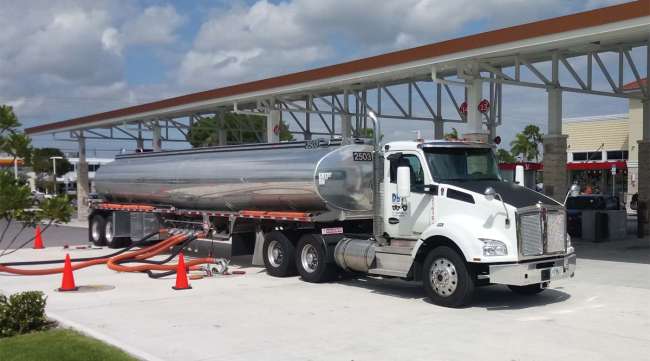Senior Reporter
Diesel Dips for Seventh Time in Eight Weeks; Zeta Pounds Gulf Coast

[Stay on top of transportation news: Get TTNews in your inbox.]
The national average price of diesel decreased three-tenths of a cent, according to the Energy Information Administration’s weekly data released Oct. 26. The drop is the seventh in the past eight weeks.
Trucking’s main fuel now costs $2.385 a gallon, which is 67.9 cents less than a year ago.
Diesel declined in nine of the 10 regions in EIA’s weekly survey. The biggest slide was in the Midwest, seven-tenths of cent to $2.262 a gallon. The fuel costs 70.1 cents less per gallon there than it did at this time in 2019.
The average price of a gallon of gasoline also fell, by seven-tenths of a cent, to $2.143 a gallon, 45.3 cents a gallon cheaper than a year ago.

In this episode, host Michael Freeze takes a look at the surprising ways trucking companies are building strong, resilient cultures and attracting talent that stays. Hear a snippet, above, and get the full program by going to RoadSigns.TTNews.com.
The most expensive diesel remains in California, the only area in the survey where it exceeds $3 a gallon. Diesel there fell four-tenths of a cent to $3.235 a gallon and is 76.3 cents less expensive than it was a year ago.
The least expensive diesel is in the Gulf Coast region, where, coincidently, it was the only area that marked an increase. The cost, which inched up three-tenths of a cent to $2.146 a gallon, is 66 cents per gallon less than it was a year ago.
The Gulf Coast is home to much of the nation’s oil and gasoline production as well as refining capacity, and again energy officials are closely watching the Gulf of Mexico.
Hurricane Zeta, the 27th named storm of the hurricane season, came ashore the night of Oct. 28 as a Category 2 storm, lashing the Louisiana coastline with 110 mph winds before being downgraded to a tropical storm and moving through Louisiana, Alabama, the Florida Panhandle, Georgia and then into South Carolina and North Carolina. It eventually reached Virginia, Maryland, Delaware and New Jersey before heading into the Atlantic Ocean and moving north.
According to offshore monitoring systems, the high winds churned up a storm surge across southeast Louisiana and created a 50-foot wave at the Louisiana Offshore Oil Port. Wind speeds near the eye of the hurricane reached 150 mph.

Home | Video | Heroes' Photo Gallery
Saluting the men and women of the trucking industry who kept America's essential goods flowing during the coronavirus pandemic.
Heroes: Peter Lacoste | Susan Dawson | James Rogers | Reggie Barrows | Kevin Cooper | Cesar Quintana Moreno
The Federal Government’s Bureau of Safety and Environmental Enforcement said Oct. 26 that nearly 67% of Gulf oil production and 45% of natural gas output was offline because of Zeta. However, earlier this month, Hurricane Delta caused 91% of Gulf energy production to be shut down. In August, Hurricane Laura resulted in 84% of production being temporarily shuttered.
Several energy companies, including Chevron, Shell, BP, BHP, Murphy Oil and Equinor, said they shut down platforms and suspended oil and natural gas production because of Zeta.
Shell said it is monitoring the storm and will be checking to see how much damage it did before sending employees back into the Gulf.
“We have safely paused some of our drilling operations, and there are currently no impacts to our production. We will continue to monitor weather reports and respond accordingly,” the company said.
This is at least the sixth time that energy companies brought their workers ashore since June, a process made more difficult by the COVID-19 pandemic with workers being required to be tested for the virus before returning to work.
Gulf of Mexico offshore production accounts for about 17% of total U.S. crude oil output and 5% of total U.S. natural gas output.
Meanwhile, the price of oil on world markets closed Oct. 26 at $40.88 a barrel.
But because of the pandemic, U.S. oil production remains far below what it was just seven months ago. EIA said production was up last week to 10.5 million barrels per day, but that’s down 2.6 million barrels per day, or 19.8%, when domestic production reached a record high of 13.1 million barrels per day before the pandemic.

Kloza
Oil industry analyst Tom Kloza, founder of the Oil Price Information Service, told Transport Topics the oil market is trading in a narrow range as demand for oil remains soft and progress on a new federal stimulus package has stalled. With the holidays approaching, Kloza said Americans already anticipate staying home. That also contributes to lower oil demand.
“So many people aren’t traveling,” he said. “The typical family get-together for Thanksgiving will likely be 25%, 30%, or 40% lower than what it was, and I think the same thing could happen for Christmas.”
Want more news? Listen to today's daily briefing:
Subscribe: Apple Podcasts | Spotify | Amazon Alexa | Google Assistant | More




